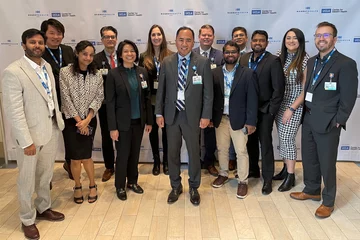Summer 2019
In August 2018, DGIT formed the Research Enablement Initiative to better understand the research community’s technology needs and develop new processes that would allow us to provide secure and sophisticated IT solutions with minimal disruption. The Research Enablement Advisory features representation from across UCLA Health sciences schools and chaired by Dr. Steve Smale has been able to achieve a wide breadth of objectives that will serve as stepping stones in building a more robust technological infrastructure for a thriving research environment.
One initiative of the initiative was to establish and implement a new faculty onboarding process. Our goal was to ensure we could onboard a faculty member as early and smoothly as possible, starting with building a close partnership with new faculty prior to their arrival. The Research Enablement Initiative began onboarding Dr. Paul Boutros, an internationally acclaimed computational oncology researcher, in June 2018.
Dr. Paul Boutros led a lab at the University of Toronto with a team of ~40 computational researchers. He and his team worked closely with intensive computational infrastructure to learn how to take big data and use it to solve important problems in cancer biology. At his lab in Toronto, his team was conducting research using several thousand CPUs analyzing several petabytes (millions of gigabytes) worth of data. Dr. Boutros decided to move his UCLA in 2018 because he believed he’d be able to do research at UCLA that couldn’t be done anywhere else in the world.
He says the “breadth and depth of researchers here is spectacular” and he wanted to “take advantage of the skills present in the best cancer center in the west coast”.
As soon as Dr. Boutros signed the dotted line to join UCLA, he was eager to know what the logistics of moving would be. In June of 2018, Paul began talking with the Business Relationship Manager for Human Genetics, Will Kugler at the time. With Will, and the computing team’s help, they were able to draft a charter that would provide a clear definition of the services needed and a timeline to relocate his existing services. Coming into UCLA, the expectation was to normalize all operations within the first 90 days. DGIT would assist in onboarding Dr. Boutros’ staff by provisioning equipment and providing access to all necessary services and applications. As we continue to assist Dr. Boutros, his BRM, currently Daniel Kasprowicz, meets with him and his team weekly to ensure his expectations are moving along as expected.
Dr. Boutros believes these regular discussions are important because, as he describes it, “it’s not just an onboarding, it’s like going through several dates”. He believes that it is critical that a PI take a lead role in the onboarding to help build the relationship with the organization and to serve as a role model to new staff they hire.
In less than a year, Paul says “things started coming together… and that’s pretty miraculous”. With the help of OHIA, his lab is being set up to include a cloud-based high performance computing (HPC) cluster and computation pipeline that will support his work. The setup allows Paul to focus on the development of clinically useful biomarkers using genomic and data science techniques like next-gen sequencing, clinical and cellular imaging, machine-learning, crowd-sourcing and cloud-computing. In the initial phase, OHIA set up a proof-of-concept HPC build for Paul’s team to test the compute capabilities of Microsoft’s cloud platform – known as Azure – that includes CycleCloud (a proprietary HPC service), Sun Grid-Engine (job scheduler) and Docker containers.
In the next year, Paul expects to be able to make use of all of UCLA Health’s IT service capabilities and begin to have things his teams wants to build out and start the first optimization. About two petabytes of data are being moved over from Toronto and he hopes to have that moved over in two years, a petabyte per year. Over the next five years, Dr. Boutros hopes to put in place a robust server system built that will allow duplication of data, and a robust data science support infrastructure to drive scientific projects.
Dr. Paul Boutros is confident that a robust technological environment that is ever changing with new capabilities will allow his team to conduct research in innovative ways to achieve a better understanding of cancer. While these will be technologically challenging, he has full confidence that DGIT will be able to tackle them: “I’ve worked with professional research IT at places throughout the world, and DGIT is up there with the best of them. I look forward to working with them to make UCLA the center of global cancer data science!”
DGIT Research Support
The Research Enablement Initiative and DGIT are excited to continue partnering with the research community. To learn more, visit the Research Enablement page.




